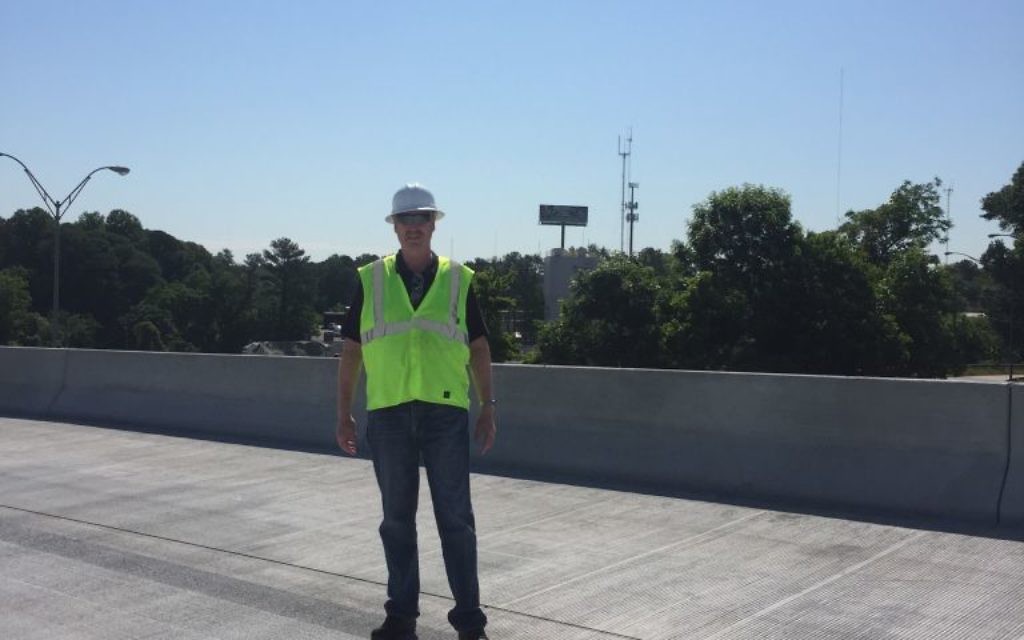Chemist Gives I-85 a Lift
New invention helps prolong durability for structures and roads.
Atlanta gained a problem-solver when Jerry Rademan and his wife, Arlene, moved from Jacksonville to Sandy Springs to be with family in 2013. Starting as an industry manager, Rademan had a stellar career developing products for the construction, plastics, photo additives and water purification markets.
Continually spotting market needs, Rademan retired from the corporate world to operate his own technical development businesses. A chemical compound he developed helped the Georgia Department of Transportation’s contractor rush the repair of Interstate 85 after the fire and bridge collapse in March.
Jaffe: Throughout your career you have worked for other companies that profited from your inventions?
Get The AJT Newsletter by email and never miss our top stories Free Sign Up
Rademan: Yes, I have worked as a new product developer and marketer for many familiar companies: Smith Corona and Ciba-Geigy (now BASF). I learned how to anticipate market needs, then develop products that meet those needs. Many hundreds of millions of dollars are spent on these products that repel water and salts from corroding concrete structures or materials that stabilize paints from mildew and algae. So it’s correct that I was salaried and got frequent promotions.
Jaffe: How long does it take to get a new product to market?
Rademan: On average it takes one to two years to tweak a product and get the patent. Sometimes up to five.
Jaffe: Explain your role in the repairing the I-85 bridge collapse.
Rademan: I developed a product called PREVent-C as a consultant for Premier Magnesia LLC that basically reduces or stops shrinkage cracking in concrete. Through market research, I found that the Chinese put magnesium oxide in concrete that inconsistently prevented cracking on several large dams in China. We invented the use of a glycol ether coating on magnesium oxide that works virtually every time. It helped shorten the time span for reopening our interstate. My dream is for every state’s DOT to use it to drastically increase the lifespan of bridges.
I presented it to the U.S. Bureau of Reclamation out West for successful use on a concrete dam spillway in Kansas. Also, the Army Corps of Engineers has now used it. The engineers from both federal agencies were amazed with its success in minimizing shrinkage cracks.
When the I-85 bridge collapse occurred in March, being an Atlantan, I am extremely pleased that GDOT recognized that PREVent-C was the right product to help shorten the time we had to endure the traffic nightmares here of finding alternative routes through Atlanta. Atlanta made national news with this bridge collapse calamity. The general contractor, who got a hefty financial bonus to make the early date, was pleased that the use of PREVent-C helped shorten the time while providing crack-free concrete decks.
Jaffe: You went to Flint, Mich., to consult on the huge water debacle?
Rademan: Yes, I visited Flint a few times to test their water in several locations and then spoke to government officials about how to overcome the high lead and copper water levels caused by the corrosion of pipes and joint solder materials. I developed a more effective water filter system called METALTRAP through my company, HydroPure Technologies Inc. The outcome was that there wasn’t sufficient funding to purchase these water filters, but federal funding under the Obama administration was finally provided for correcting the problem by replacing the infrastructure by tearing out the old pipes and replacing them with noncorrosive PVC pipes. This is a long-term project that unfortunately will not satisfy the shorter-term needs of many residents of Flint.
As I am sure you re aware, Atlanta (and other major cities) have similar issues, but to a far lesser extent compared to Flint.
Jaffe: What’s in the future for your creativity? I know your mind is always thinking a step ahead.
Rademan: We are working on novel wall technologies that could potentially save lives. Unfortunately, on the news we see high-rises quickly go up in flames, most recently London and Dubai. Today’s conventional wall products can contain a fire for about one hour before penetration. By replacing it with this newer technology, that time could double to two hours using the same wall assembly dimensions. Think about that in terms of escaping a building.





comments